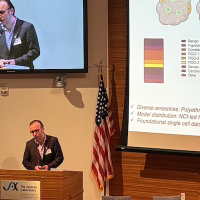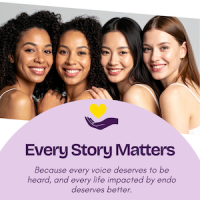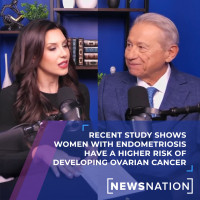
Pamela Bove suffered from severe endometriosis symptoms for 16 years before finding out in 2022 that she had the disease. She stumbled upon the eventual diagnosis as an administrative assistant in a minimally invasive gynecological surgery office in Boston. While setting up appointments for patients and listening to their stories, she recognized that their symptoms often matched her own.
“When I realized I had endometriosis and the immense number of other people who were dealing with it, it truly made me feel less alone,” Bove said. “But it was also sad because you realize the millions of people worldwide who are dealing with something that is still not talked about enough. I’m telling my story because I’d love to be able to create change if I can.”
Bove, 36, began experiencing symptoms in high school 20 years ago.
“I felt pelvic pain chronically and had issues with my bowels, nausea, full-body fatigue, and bloating,” Bove said. “I also noticed my cycles were really long. When I would talk about it with my peers, they’d say, ‘Oh, it doesn’t hurt for me,’ or ‘I only have my period for three to four days.’ I thought that was strange. It was seven to 15 days for me. Sometimes, I’d even have pain in between my cycles.”
Bove went to her school nurse seeking relief. She found none.
“You’d think she’d have some range of knowing what was wrong, but she’d just say it was cramps and that they were normal. Then she’d give me a heating pad and ibuprofen and have me lie on the cot in her office for 30 minutes before sending me back to class,” Bove said. “I wasn’t getting answers or even guidance. She’d call home and tell my family I was having tummy pain.”
Knowing nobody else who could relate to her experience and feeling lost, Bove saw an OBGYN for the first time.
“I mentioned the long periods, the pain on and off my cycle, and the other symptoms. They just dismissed it all and said it was part of being a woman,” Bove said. “They prescribed me oral birth control, which helped shorten my periods, but the symptoms never went away.”
This way of life continued throughout her 20s. Despite seeing her primary care physician and gynecologist annually, no one had a solution. Bove went to the emergency room a few times in that decade, including one incident in 2016 when she drove herself there because of a horrific stabbing pain in her pelvic region.
“They did an ultrasound and said they didn’t see anything,” Bove recalled. “They said it may have been a ruptured cyst and that the pain would go away. They told me to follow up with my gynecologist and never dove any deeper. I just accepted that this was my life. I had it worse than others and would just have to deal with it.”
She did, and it wasn’t easy. Along with the endometriosis symptoms, Bove began feeling side effects from the birth control. Also, with a job in retail at the time, taking any time off due to illness was frowned upon in the industry. All of this contributed to her deteriorating mental health.
In the fall of 2018, a new symptom arose: chest pain so intense that it hurt to breathe. Afraid to call in sick to work, Bove endured it for two days before going to the ER. She had three pulmonary embolisms, which the doctor said were the result of the combination of an inherited prothrombin gene mutation (which increases the risk of blood clots) and the birth control she was on. She was admitted to the hospital and put on blood thinners.
“Now I was terrified to be on birth control,” Bove said. “When I stopped taking it, my [endometriosis] symptoms got worse and more frequent.”
Bove left her retail job in 2021 and, with previous experience working in a hospital, was hired as the administrative assistant in the minimally invasive gynecological surgery practice in Boston.
“After some time in the practice while talking to patients, I realized I was hearing many of the same stories, and I was hearing my own symptoms in those stories,” Bove said. Several of those patients had been referred by other doctors and had endometriosis. “I went to one of our providers and said, ‘I really need to know if I have it. Can you help me?’ They said, ‘Yes, let’s get you in for an MRI.’ That led to me finding out that I had endometriosis, along with adenomyosis.”
She had a consultation later that year, and the surgeon told her they could do excision surgery.
“But they made it abundantly clear that there was no cure, that the lesions could come back,” Bove said. “That experience was validating because I finally had answers and knew this wasn’t in my head, but it was also completely heartbreaking because I had something that had no cure.”
Bove underwent a laparoscopic excision of endometriosis with a full pelvic peritonectomy in December 2022. Her endometriosis was stage II.
“Recovery was about eight weeks, and then a few months went by where I was symptom-free,” Bove said. “But about midway through 2023, I felt the symptoms again. By 2024, they were back in full force.”
Bove saw her gynecologist, who thought the problem could be with the strength of the IUD that was inserted during surgery. They replaced it with a new one, but the symptoms persisted. The gynecologist then ordered an MRI. The results showed that the uterus was of normal size, “unremarkable,” and the IUD was where it should have been. The problem—which the radiologist somehow failed to mention in the report—was that her uterus wasn’t where it should have been.
“They referred me back to minimally invasive gynecological surgery, and the surgeon said the endometriosis had returned,” Bove said. “He said it had progressed to the point where my whole reproductive system was fused to my left pelvic wall and bowels. My uterus wasn’t even centered.”
Bove underwent another laparoscopic excision of endometriosis with lysis of adhesions this past June.
“Thank God they caught everything when they did,” Bove said. “It’s all just been very scary.”
Since she works remotely for the most part, she was able to return to her job after four weeks.
“If I have a flare-up or wake up in pain, I don’t have to work that day. I’m very fortunate to work for an organization that understands this condition and is able to accommodate me,” Bove said. “I can see how living with this disease can ruin people’s chances of a career and put them in a difficult position with employers.”
Bove doesn’t know what her future with the disease holds or, since she has adenomyosis, if she eventually will need a hysterectomy. Right now, she’s living one day at a time. Along with her work, she’s a full-time college student and expects to earn her bachelor’s degree in health care administration next May. She’s also dedicating as much time as she can to helping other women with endometriosis. Sharing her story here is one example. She also has created an Instagram page that shares facts and stories about the disease.
“It’s a major women’s health issue, and I wanted to get involved,” Bove said. “How can we create more awareness and invoke change in how patients are receiving care? Across the country, patients are not receiving the full range of services they need, and it’s taking a long time to get a diagnosis. I know. It happened to me.”
Follow Bove and connect with other women with endometriosis on her Instagram page @endowithpam.
*Patient stories submitted to EndoFound.org are the patient's views, not necessarily those of the foundation. All testimonials are from real patients, may not reflect the typical patient’s experience, and are not intended to represent or guarantee that anyone will achieve the same or similar results.









